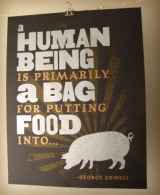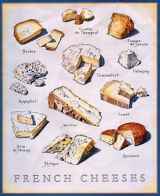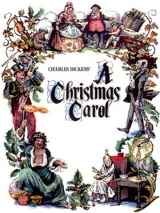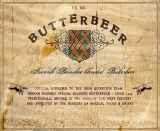Four of the Best Literary Feasts
Finding one specific reason as to why books are loved is a fairly feckless task; for some it’s a novel’s concentration of plot, whereas others are captured by an intense plot twist. Dramatic denouements have some readers coming back for more while certain booklovers think opulent descriptions are a must. Personally, I don’t have to forage very far for the one feature of literature that satisfies me more than most. The presence of food – be it used as a vehicle to develop a character or employed to enhance my sensory understanding of the text – has fascinated me for years. Thinking about it, I struggle to remember truly enjoying a book that hasn’t in some small way found descriptive solace through food.
Food surrounds and defines our daily lives and as such, it comes as no surprise that some of our best loved characters are blessed with the opportunity to fill their bellies with wonderfully evocative ingredients; think of Enid Blyton’s famous five and their prodigious eating capabilities. Or of the smells and textures of madeleines that perfume Marcel Proust’s In Search of Lost Time; the intense green hue that emanates from Dr. Seuss’ Green Eggs and Ham and the salinity of Ernest Hemingway’s oysters in A Moveable Feast fill their pages with gastronomic delight.
Try and read a novel written by Roald Dahl that doesn’t mention food; he was obsessed by feeding his characters. James and the Giant Peach and Charlie and the Chocolate Factory are the most instantly recognisable, while Matilda contains perhaps the greatest act of food rebellion in children’s literature; Bruce Bogtrotter’s successful battle with the world’s largest chocolate cake.
Entire novels have been devoted to the relentless pursuit of the ultimate evocation of food; Gabrielle Hamilton pours her heart into Blood, Bones and Butter while Alice B. Tolkas’s cookbook is as much a guide to life that uses food as its inspiration at every turn.
I’ve attempted – though no doubt with only a small degree of success – to select just four of my favourite pieces of literature that in are in some way augmented by their use of food.
4. George Orwell’s Dirty Kitchen
 George Orwell’s Down and Out in Paris and London recounts his struggles with penury and, subsequently, there is a resolute focus on the issues of food that are inextricably linked to poverty; the incessant bouts of bread and butter surrounded by vultures and of the ignominy of shopping with little money. What makes Down and Out particularly poignant is the fact that Orwell doubtlessly appreciated good food. His 1945 essay entitled In Defence of English Cooking lauds the merits of English cuisine and yet, the most memorable food scene in Down and Out arrives in the grim kitchens of Paris, bringing with it the fear that stubbornly refuses to depart from our consciences: what really happens behind the kitchen door.
George Orwell’s Down and Out in Paris and London recounts his struggles with penury and, subsequently, there is a resolute focus on the issues of food that are inextricably linked to poverty; the incessant bouts of bread and butter surrounded by vultures and of the ignominy of shopping with little money. What makes Down and Out particularly poignant is the fact that Orwell doubtlessly appreciated good food. His 1945 essay entitled In Defence of English Cooking lauds the merits of English cuisine and yet, the most memorable food scene in Down and Out arrives in the grim kitchens of Paris, bringing with it the fear that stubbornly refuses to depart from our consciences: what really happens behind the kitchen door.
Of course, kitchen wives’ tales are boundless and often untrue but yet, Orwell’s illustration of a chef who picks up meat ‘in his fingers and slaps it down, runs his thumb along the dish and licks it to taste gravy’ is decidedly accurate. I have fond memories of Marco Pierre White acting with diligence in front of television cameras, uncomfortably swapping spoons every time he readjusted a dish’s seasoning. Indeed, I’ve been in kitchens where food has been flung from corner to corner and sauces have been tasted by finger to finger.
This lucid anecdote in Orwell’s memoir is one of many that are relatable to modern society, in spite of nearly a century’s time difference.
3. Zola’s Parisian Paradise
 If this article inspires you to read just one of these books, make it Émile Zola’s Le Ventre de Paris (directly translated as The Belly of Paris). Amid a warts-and-all representation of socialist uprisings, Zola forms a Parisian landscape that is overflowing with a riot of incongruent food sketches. Its inhabitants sleep and fornicate on cabbage patches and its market inspectors frequently encounter fish guts. Conversely, there are plenty of moments that depict gastronomic beauty. Charcuteries gleam with the deep, paprika-red hue of hanging hams. Zola slowly layers Parmesans on top of Gruyeres in a wonderful paragraph that climaxes with the intense pong of Camembert to give the novel a redolent whiff of the cheeses that are so associable with France. The Belly of Paris is a novel that captures everything about the city’s food scene in a way that almost lets you taste the food; almost.
If this article inspires you to read just one of these books, make it Émile Zola’s Le Ventre de Paris (directly translated as The Belly of Paris). Amid a warts-and-all representation of socialist uprisings, Zola forms a Parisian landscape that is overflowing with a riot of incongruent food sketches. Its inhabitants sleep and fornicate on cabbage patches and its market inspectors frequently encounter fish guts. Conversely, there are plenty of moments that depict gastronomic beauty. Charcuteries gleam with the deep, paprika-red hue of hanging hams. Zola slowly layers Parmesans on top of Gruyeres in a wonderful paragraph that climaxes with the intense pong of Camembert to give the novel a redolent whiff of the cheeses that are so associable with France. The Belly of Paris is a novel that captures everything about the city’s food scene in a way that almost lets you taste the food; almost.
If you’re after a novel which is blessed with a thrilling narrative, The Belly of Paris probably isn’t what you’re looking for. Though its central protagonist, Florent, imprisoned during the French coup d’état of 1851, is a curious man whose life is fraught with moral and political dilemmas, the novel’s real strength comes through its anthropological take on society as defined by its food. A perfect novel to read if you’re about to travel to France, or if you’re in the mood to get your saliva flowing.
2. Dickens’ Christmas Turkey
 Forget every abhorrent expletive you’ve ever said about the world’s favourite bird; less a gastronomic delight but more a traditional protocol, the turkey has been greeting festive dining tables for centuries (it supposedly became the British centrepiece in the 16th Century). The bird’s prandial importance certainly wasn’t lost on Charles Dickens, whose loathsome character Ebeneezer Scrooge in A Christmas Carol uses the turkey to signal his transformation from dogged avoider of Christmas traditions to a man who embraced their warm charms with open arms. As the line goes, ‘it was even said of him that he knew how to keep Christmas well’.
Forget every abhorrent expletive you’ve ever said about the world’s favourite bird; less a gastronomic delight but more a traditional protocol, the turkey has been greeting festive dining tables for centuries (it supposedly became the British centrepiece in the 16th Century). The bird’s prandial importance certainly wasn’t lost on Charles Dickens, whose loathsome character Ebeneezer Scrooge in A Christmas Carol uses the turkey to signal his transformation from dogged avoider of Christmas traditions to a man who embraced their warm charms with open arms. As the line goes, ‘it was even said of him that he knew how to keep Christmas well’.
Sure, every Christmas table is improved by the omission of turkey, but its dry flesh does seem to have a hold over us. That many of us persist with it each year emphasises its importance to A Christmas Carol. Scrooge’s grand gesture was made in the spirit of Christmas and for that, Dickens’ novel should be treasured by every lover of Christmas food.
1. J.K’s Joyous Feasts
 One of the great mysteries of Harry Potter (for there are many) is just how so few of the characters are described as being overweight. Nearly every food seems to be laden with fat or sugar; chocolate frogs are the first snack that greets Harry on his first journey to Hogwarts. There must be some sort of clandestine fitness class within Hogwarts; that or they all have tremendous self-restraint.
One of the great mysteries of Harry Potter (for there are many) is just how so few of the characters are described as being overweight. Nearly every food seems to be laden with fat or sugar; chocolate frogs are the first snack that greets Harry on his first journey to Hogwarts. There must be some sort of clandestine fitness class within Hogwarts; that or they all have tremendous self-restraint.
Sustenance comes in all forms; pumpkin pasties, Mrs. Weasley’s innumerable sausages and any number of sinful sweets. Then there are all the tarts, puddings and Peppermint Imps. To wash these down, butterbeer, a drink that promises all kinds of salacious beauty; I used to dream how sweet its froth was, with J.K. Rowling’s admission that it tastes ‘a little bit like less sickly butterscotch’ only cementing my image of it as the most ambrosial beverage in literature.
And I suppose that’s exactly why I love the food and drink in Harry Potter. Rowling’s characters are privy to the kind of diet that we invariably deny ourselves. She manages to capture our palates’ greatest desires and cravings for sweet and savoury food without making the references too far removed from our daily comestibles. Though there are occasional caveats (Berti Bott’s Every Flavour Bean and butterbeer, for instance), the wizards and witches enjoy much of the same food as we do. Rowling successfully makes the gastronomy of her subterranean magical world accessible and a joy to read.
Thought of any glaring omissions? I’d love to hear of your most treasured memories of food in books, and maybe even discuss a literature-inspired recipe or two!
What do you think? Leave a comment.











This is a fine list and makes me want to re-read ‘Down and Out’. It also made me very hungry. My personal favourite is’The Hobbit’. I’ve re-read every couple of years for the last decade and every time the Party eats, whether it be at Bag-End or Beorn’s house, it always makes my mouth water.
Hi Joseph, glad you liked it. Writing this list made me want to re-read Down and Out as well.
Nice list! – I definitely agree on JK’s use of food, it’s delicious and mind boggling at the same time. I reckon Laura Esquivel’s use of food in Like Water for Chocolate explores an intriguing exploration of food and I always feel the urge to cook something after reading anything by Murakami – his characters are always eating.
But for your focus on the explicit, almost central use of food – your four seem perfect – though I’ve yet to read Zola, something to pop on the reading list.
Hi Aliya, I’ve never read anything by Murakami – I take it you’d recommend him?
Zola’s literature makes me want to cook straight after, too.
Oh definitely, I love Murakami – his writing is, hmmm I’m not sure of the right label, but magical realism/surrealism or possibly absurdism with a consistent thread of realism throughout, so if you’re interested in that particular genre, then he’s definitely worth a read. Some of his writing can be frustrating in that aspect because the genre often bypasses clarity, but the mystery is captivating.
He uses food in a subtle way, it’s not obvious, but it’s inherently part of the character’s routines and they’re so meticulous about cooking; it always feels like a fundamental aspect of their lives which is why I thought of him when reading your article.
If you are intrigued, he wrote a short story collection called The Elephant Vanishes which is a good way to see if his work entices you,(The Dancing Dwarf is pure magic) though I do think his novels do more justice to his skill – The Wind Up Bird Chronicle is possibly my favourite. If you ever do get round to reading it, do let me know your thoughts 🙂
I second that, Aliya. Murakami is an excellent read and a good introduction to him is The Elephant Vanishes, one of his more famous novels, though is 1Q84.
Creative article! Enjoyed reading it.
The Belly of Paris is quite an underrated title but if you are into Zola, I would highly recommend her better books like Germinal, La Terre, L’Assomoir.
Hey Daniele, I totally agree. I think The Belly of Paris is a must for any who’s interested in French cuisine.
I’ve been slowly working my way through L’Assomoir for a while now; can’t say I’m loving it but I’m determined to read all of the Les Rougon-Macquart series some day.
Orwell’s book is probably one of the best-written accounts of the bumming life ever penned. One can learn a lot in this one.
Lovely writing. Have you read “Blood, Bones, and Butter”. Oh and another cliche is of course “The Physiology of Taste”.
This article has made me very hungry!!
One of my personal favourites is from Roald Dahl: his description of Mr Twit’s beard being full of “dried up scrambled egg … spinach and tomato ketchup and fish fingers and minced chicken livers and all the other disgusting things Mr Twit liked to eat”! is the perfect introduction for this awful character!
Such is a very well written article. Would love to read more but I’m now off for a bite to eat…!
I would have been really disturbed if you would have had “Naked Lunch” in here…I would like to think that no one would eat any kind of substance described in that book…cool idea for an article though, nice work!
I’m currently reading Andrea Camilleri’s “The Wings of the Sphinx”. He writes a lot about cuisine in his book series, even though it has no significant role to the plot. Still, it’s interesting to see how authors spend so much time talking about food in a way!
Great article Joe thanks. I’d like to remind you of our friend Winnie the Pooh – who’s life is centred on his pot of honey…
“A day without friends is like a pot without a single drop of honey left inside.”
– Winnie the Pooh
Great article! I’ve noticed that a book is captivating when it has created a moody and affecting sensory experience. Food is one valuable way of achieving this.
I really enjoyed reading this, and kudos for the use of ‘feckless’, great word. Possibly a fairly obvious example, but the descriptions of food that’ve stuck with me most over the past couple of years are probably those from the Song of Fire and Ice (Game of Thrones) series. Martin’s descriptions of the various feasts are apt to make the mouth water, so much so that they released a cookbook!
You might be interested in the use of food in film, too; it’s a motif that’s a particular favourite with the Surrealists because of the routines and rituals that surround mealtimes and food as an integral aspect of living. A couple of examples would be Jan Svankmajer’s short film ‘Food’, which is split into three sections for the three meals of the day, to wrap a message about the cannibalistic nature of Communist society in black humour. I’d also suggest Luis Buñuel’s ‘The Discreet Charm of the Bourgeoisie’ and ‘Phantom of Liberty’, both of which examine the peculiarities of social rituals.
http://www.youtube.com/watch?v=h1Mptgi23YE
I think Rowling’s descriptions of food are one of my favourite parts of her books. Great article! You really aptly highlight what an interesting and often overlooked aspect of literature food is.
fascinating article! i cant help but also think of Shakespeare and the way he presents food! The feast of temptation in The Tempest stands out for me!
What a cool idea for an article! It may not have been the most mouthwatering, but I love the passage in E.B. White’s Charlotte’s Web where the animals try and convince Templeton to go to the fair by describing the vast quantities and varieties of food that humans leave strewn about the fairgrounds. So vivid!
As an English major, I hadn’t thought much about the presence of food in literature, but this article really opened my eyes to moments in literature in which food is focus and brings people together. And I’m glad you put the feasts in Harry Potter as #1 because Rowling really does describe them in great detail and they always make my mouth water!
Great article.
I share your passion for food and literature as well, Joe. I’ll have to go back and revisit some of these texts in light of your analysis.
I was wondering however, if you’ve read Ian McEwan’s ‘Saturday’? It features, in ravishing detail, the creation of a fish stew that sent me straight to the fish monger. McEwan has even featured the recipe on his personal website. Yet, the biggest draw, the one that struck me as sonorous, was when I read Adam Gopniks, wonderful look at McEwan, the fish stew, and its place in literature. Joe, I believe you’d absolutely dig Gopnik’s ‘The Table Comes First’. It’s more than about food and literature, but no sense in not expanding one’s palette, right?
As I was reading the beginning of this article I was reminiscing about the time I read Harry Potter for the first time and how I salivated at her description of Hogwarts feasts. I was pleased to see you acknowledged it! I also enjoyed the sensory imagery of Patrick Süskind’s ‘Perfume: The Story of a Murderer’. A very interesting aspect of literature to focus on. I enjoyed reading it!
Harry Potter and The Hobbit are definitely part of the list, such as Zola and Roald Dahl. I would add Virginia Woolf (A room of one’s own)and Proust.
In another form, I love the Be Our Guest sequence in Disney’s Beauty and the Beast – a real ode to culinary art!
This list is perfect! The feasts in Harry Potter were seriously the most beautifully described dinners, I get hungry just reading about the treacle fudge, and Shepard’s Pie. I think it was one of the few books that could make every British dish sound delicious. But you’re also right, how did not one character ever have issues with their weight? Maybe they had a gym Harry never talked about.
Agreed. Harry Potter feasts were the first thing I thought of while reading this article. Its a lot like food porn tumblrs haha
Mmmm, I’m hungry just reading this excellent article. I’ms use I remember J.K. said in an interview once that one of her favourite children’s authors always listed the exact food her characters were eating, and so she sought to do the same in her work. Great stuff.
You missed the feast from Gravity’s Rainbow…! Good times.
Zola’s naturalistic writing makes excellent use of food.
I do think this list needs to be five-long, and include Hemingway’s ‘A Moveable Feast.’ This is a really delectable sample:
“As I ate the oysters with their strong taste of the sea and their faint metallic taste that the cold white wine washed away, leaving only the sea taste and the succulent texture, and as I drank their cold liquid from each shell and washed it down with the crisp taste of the wine, I lost the empty feeling and began to be happy and to make plans.”
I think Paris, and especially its food, has a unique ability to bring out the best and worst of writers and maybe normals as well. That was definitely the case for Hemingway, although I think the city’s delicacy too tame for Papa.
Hi Stephen,
thanks for your comment. It’s funny you should mention Hemingway and Paris. While I wrote this article I was also finishing off a dissertation on the relationship between food and literature in 1920s Paris.
Maybe I was too close to that topic (it covered Hemingway, Fitzgerald, a little bit of Joyce to name but a few) to talk about A Moveable Feast here.
I agree with you though – Hemingway’s gastronomic depictions in AMF are astoundingly clear and evocative. He had an ability to write about food as succinctly and poignantly as the best food writers since the 20th century.
Perhaps I’ll write an article solely on his use of food and drink soon…
Great, now I’m hungry. 🙂 Seriously though, nice work. I especially enjoyed your last two literary feasts. A few thoughts, if you ever want to expand on this idea:
1. Scrooge’s gift of Christmas turkey actually replaces the “very small” goose he saw in his visit to the Cratchits with the Ghost of Christmas Present. On his wages, a small goose would’ve been all Bob Cratchit could afford, as the ghost points out. Additionally, although opinions on its actual flavor vary, goose is quite a greasy, somewhat gamey bird. It would’ve been more common in Dickensian London than turkey, which, dry though it is, would’ve been an extravagance and perhaps considered more flavorful. Therefore, Scrooge’s gift becomes all the more magnanimous.
2. Why is almost no one in the HP universe overweight despite their indulgent diet? Well, just a thought, but maybe it’s because the indulgence brings them such joy. The theory being, if you eat what you want, your body responds by releasing more energy and endorphins. Also, recall that Harry himself has never been indulged with food. If anything, he was wasting away before Hogwarts. This could be a metaphor for his emotional life as well. In other words, he comes to Hogwarts and gets fed physically, which helps him strengthen and grow. But through the joy and camaraderie of food, Harry is also nourished emotionally. This gives him some of the foundation he needs to determine his own identity, stand up for himself and others, and become a wizarding world leader.